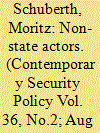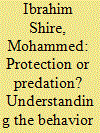| Srl | Item |
| 1 |
ID:
140340


|
|
|
|
|
| Summary/Abstract |
The proliferation of irregular armed actors which defy simplistic definition has caught public and academic attention alike, not least in the pages of this journal. To move the debate on non-state armed groups (NSAGs) forward, this article seeks to enhance our conceptual understanding of parochial armed groups which are not primarily driven by ideological or religious objectives. Thus, this article clarifies similarities as well as differences between subtypes of community-based armed groups (CBAGs) on the one hand, and between CBAGs and other NSAGs, on the other hand. By doing so, a typology is developed that classifies militias, gangs and vigilantes on the basis of their political, economic and security-related dimensions. The resulting ideal types are discussed through the lenses of different explanatory frameworks and policy debates in the field of contemporary security studies. A major typological issue is the tendency for CBAGs to ‘turn bad’ and become threats to the stability they were expected to transform, becoming a serious problem in countries where they operate. It is concluded that the challenge of CBAGs ultimately needs to be addressed by putting in place a functioning state that can tackle the underlying woes that led to their proliferation in the first place.
|
|
|
|
|
|
|
|
|
|
|
|
|
|
|
|
| 2 |
ID:
184184


|
|
|
|
|
| Summary/Abstract |
During civil wars, some communities raise self-defense militias to protect themselves from insurgent predation, but these militias can end up mutating into predatory organizations. The extant literature has focused chiefly on the predatory propensity of state-created self-defense militias and has mostly overlooked why some community-created self-defense militias segue into predatory organizations while others eschew predation altogether. This study explains this phenomenon, drawing on in-depth interviews with active members of two community-created self-defense militias (Ahlu Sunna Waljama’a and Macawiisley) in Somalia. In doing so, two sequential mechanisms (sponsorship and mobility) that determine the propensity of predatory behavior are introduced. Self-defense militias that conduct offensive operations engage in predatory behavior, irrespective of whether they are sponsored locally or have external patrons. Externally sponsored self-defense militias that engage in offensive operations attract opportunistic recruits and become motivated by material benefits, while community-sponsored self-defense militias that conduct offensive operations instrumentalize their position to settle old scores against rival communities. By contrast, self-defense militias that restrict their operations to defensive activities typically recruit dedicated homegrown members, and are regulated by community-managed accountability mechanisms that prevent predatory and abusive behavior. This community control remains crucial for defensive self-defense militias, who must balance external patrons’ strategic aims with their local objectives.
|
|
|
|
|
|
|
|
|
|
|
|
|
|
|
|